Use of Discrete Element Modelling to Evaluate the Parameters of the Sampling Theory in the Feed Grade Sampler of a Sulphide Gold Plant
Abstract
:1. Introduction
2. Configuration of the Sampler and Simulations
- Movement direction: perpendicular to the flow;
- Cutter aperture (A): 60 mm;
- Cutter edge angle (γ): 70°;
- Cutter angle (α): 60°;
- Cutter velocity (Vmax): 45 cm/s;
- Solids feed rate: 73 t/h.
- The Young’s Modulus (or Loading Stiffness) for particles was 1 × 107 N/m2, and for boundaries, 1 × 1011 N/m2;
- The constant adhesive model was used, and the adhesive distance was based on 1/2 particle diameter of the smallest group of particles;
- The restitution coefficient for all particles and all types of interactions was 0.3;
- The friction coefficient for particle/belt interactions was 0.7;
- The friction coefficient for particle/boundary interactions was 0.5.
3. Materials and Methods
- Bulk density;
- Particle density;
- Size distribution;
- Gold analysis by size;
- Internal friction angle;
- Repose angle;
- Moisture.
- Sliding friction coefficient;
- Rolling friction coefficient;
- Attractive force;
- Particle size;
- Particle shape.
- Cutter aperture (A);
- Cutter angle (α);
- Cutter edge angle (β);
- Cutter velocity (Vmax);
- Solids feed rate in the sampler.
4. Results
4.1. Physical Parameters Characterization
4.2. Particle Interactions Calibration
4.3. Simulations
4.3.1. Cutter Aperture
4.3.2. Cutter Angle
4.3.3. Cutter Edge Angle
4.3.4. Cutter Velocity
4.3.5. Solids Feed Rate
5. Conclusions
- Cutter aperture (A): 4 times the diameter of the largest particle;
- Cutter angle (α): ≥50°;
- Cutter edge angle (γ): ≥50°;
- Cutter velocity (Vmax): ≤45 cm/s;
- Solids feed rate in the sampler: All the simulations presented acceptable results for extraction ratio.
Author Contributions
Funding
Acknowledgments
Conflicts of Interest
References
- Gy, P.M. Sampling of Heterogeneous and Dynamic Material Systems: Theories of Heterogeneity, Sampling and Homogenizing; Elsevier: Amsterdam, The Netherlands, 1992; p. 653. [Google Scholar]
- Chieregati, A.C.; Delboni, H.; Pignatari, L.E.C.; Pitard, F.F. Proactive reconciliation as a tool for integrating mining and milling operations. Int. J. Min. Sci. Technol. 2019, 29, 239–244. [Google Scholar] [CrossRef]
- Pitard, F.F. Pierre Gy’s Sampling Theory and Sampling Practice: Heterogeneity, Sampling Correctness, and Statistical Process Control, 2nd ed.; CRC Press: Boca Raton, FL, USA, 1993; p. 488. [Google Scholar]
- Chieregati, A.C.; Pitard, F.F. Amostragem. In Tratamento de Minérios, 6th ed.; CETEM/MCTIC: Rio de Janeiro, Brazil, 2018; pp. 27–65. [Google Scholar]
- Pitard, F. Theory of Sampling and Sampling Practices, 3rd ed.; CRC Press: Boca Raton, FL, USA, 2019; p. 726. [Google Scholar]
- Cleary, P.W.; Robinson, G.K.; Sinnott, M.D. Use of Granular Flow Modelling to Investigate Possible Bias of Sample Cutters, Proceedings of the Second World Conference on Sampling and Blending, Twin Waters, QLD, Australia, 10–12 May 2005; Australasian Institute of Mining and Metallurgy: Melbourne, VIC, Australia, 2005; pp. 69–81. [Google Scholar]
- Cleary, P.W.; Robinson, G.K. Analysis of Vezin sampler performance. Chem. Eng. Sci. 2011, 66, 2385–2397. [Google Scholar] [CrossRef]
- Robinson, G.K.; Sinnott, M.D. Discrete element modelling of square cross-belt samplers with baffles. In Proceedings of the 5th World Congress on Sampling and Blending, Santiago, Chile, 25–28 October 2011. [Google Scholar]
- Cleary, P.W.; Robinson, G.K. Sampling of cohesive bulk materials by falling stream cutters. Chem. Eng. Sci. 2011, 66, 3991–4003. [Google Scholar] [CrossRef]
- Cleary, P.W.; Robinson, G.K. Evaluation of cross-stream sample cutters using three-dimensional discrete element modelling. Chem. Eng. Sci. 2008, 63, 2980–2993. [Google Scholar] [CrossRef]
- Cleary, P.W.; Robinson, G.K.; Golding, M.J.; Owen, P.J. Understanding factors leading to bias for falling-stream cutters using discrete element modelling with non-spherical particles. Chem. Eng. Sci. 2008, 63, 5681–5695. [Google Scholar] [CrossRef]
- Cundall, P.A.; Strack, O.D.L. A discrete numerical model for granular assemblies. Geotechnique 1979, 29, 47–65. [Google Scholar] [CrossRef]
- Ilic, D. Development of design criteria for reducing wear in iron ore transfer chutes. Wear 2019, 434–435, 202986. [Google Scholar] [CrossRef]
- Shen, J.; Roberts, A.; Wheeler, A. Dem simulations on gate loads and bin storage characteristics before discharge. Powder Technol. 2021, 383, 280–291. [Google Scholar] [CrossRef]
- Patinge, S.; Prasad, K. Screw feeder performance prediction using Discrete Element Method (DEM). Int. J. Sci. Eng. Res. 2017, 8, 48–51. [Google Scholar]
- Ilic, D.; Lavrinec, A.; Orozovic, O. Simulation and analysis of blending in a conveyor transfer system. Miner. Eng. 2020, 157, 106575. [Google Scholar] [CrossRef]
- Dallinger, N.; Hubler, J. Simulation of bottle conveyors—Opportunities of the Discrete Element Method (DEM). In Proceedings of the International Symposium Plastic-Slide-Chains and Tribology in Conveyor Systems, Chemnitz, Germany, 11–12 April 2017; Volume 3, pp. 78–86. [Google Scholar]
- Shen, J.; Wheeler, C.; Ilic, D.; Chen, J. Application of open source FEM and DEM simulations for dynamic belt deflection modelling. Powder Technol. 2019, 357, 171–185. [Google Scholar] [CrossRef]
- Silva, B.B.; Cunha, E.R.; Carvalho, R.M.; Tavares, L.M. Modeling and simulation of green iron ore pellet classification in a single deck roller screen using the discrete element method. Powder Technol. 2018, 332, 359–370. [Google Scholar] [CrossRef]
- Engineering Simulation and Scientific Software Rocky (ESSS-Rocky), version 4.3; Rocky-Dem Technical Manual; Engineering Simulation and Scientific Software (ESSS): Rio de Janeiro, Brazil, 2018.
- Ilic, D. Bulk Solid Interactions in Belt Conveying Systems. Ph.D. Thesis, The University of Newcastle, Callaghan, Australia, 2013; p. 274. [Google Scholar]
- Ilic, D.; Roberts, A.; Wheeler, C. Modelling bulk solid flow interactions in transfer chutes: Accelerated flow. Chem. Eng. Sci. 2019, 209, 115197. [Google Scholar] [CrossRef]
- Barrios, G.K.P.; Carvalho, R.M.; Kwade, A.; Tavares, L.M. Contact parameter estimation for DEM simulation of iron ore pellet handling. Powder Technol. 2013, 248, 84–93. [Google Scholar] [CrossRef]
- Ilic, D.; Roberts, A.; Wheeler, C.; Katterfeld, A. Modelling bulk solid flow interactions in transfer chutes: Shearing flow. Powder Technol. 2019, 354, 30–44. [Google Scholar] [CrossRef]
- Roessler, T.; Richter, C.; Katterfeld, A.; Will, F. Development of a standard calibration procedure for the DEM parameters of cohesionless bulk materials—Part I: Solving the problem of ambiguous parameter combinations. Powder Technol. 2019, 343, 803–812. [Google Scholar] [CrossRef]
- Zhou, Y.C.; Xu, B.H.; Yu, A.B.; Zulli, P. An experimental and numerical study of the angle of repose of coarse spheres. Powder Technol. 2002, 125, 45–54. [Google Scholar] [CrossRef]
- Grima, A.P.; Wypych, P.W. Discrete element simulations of granular pile formation: Method for calibrating discrete element models. Eng. Comput. 2011, 28, 314–339. [Google Scholar] [CrossRef]
- Coetzee, C.J. Review: Calibration of the discrete element method. Powder Technol. 2017, 310, 104–142. [Google Scholar] [CrossRef]
- Roessler, T.; Katterfeld, A. DEM parameter calibration of cohesive bulk materials using a simple angle of repose test. Particuology 2019, 45, 105–115. [Google Scholar] [CrossRef]
- Ajmal, M.; Roessler, T.; Richter, C.; Katterfeld, A. Calibration of cohesive DEM parameters under rapid flow conditions and low consolidation stresses. Powder Technol. 2020, 374, 22–32. [Google Scholar] [CrossRef]
- Cheng, H.; Shuku, T.; Thoeni, K.; Tempone, P.; Luding, S.; Magnanimo, V. An iterative Bayesian filtering framework for fast and automated calibration of DEM models. Comput. Methods Appl. Mech. Eng. 2019, 350, 268–294. [Google Scholar] [CrossRef]
- Wensrich, C.M.; Katterfeld, A. Rolling friction as a technique for modelling particle shape in DEM. Powder Technol. 2012, 217, 209–417. [Google Scholar] [CrossRef]
- Antony, J. Design of Experiments for Engineers and Scientists, 2nd ed.; Elsevier: Amsterdam, The Netherlands, 2014. [Google Scholar]
- Horn, E. The Calibration of Material Properties for Use in Discrete Element Models. Ph.D. Thesis, Stellenbosch University, Stellenbosch, South Africa, 2012. [Google Scholar]
- El Kassem, B.; Salloum, N.; Brinz, T.; Heider, Y.; Markert, B. A semi-automated DEM parameter calibration technique of powders based on different bulk responses extracted from Auger Dosing experiments. KONA Powder Part. J. 2021, 38, 235–250. [Google Scholar] [CrossRef]
- Example of Create General Full Factorial Design. 2018. Available online: https://support.minitab.com/en-us/minitab/18/help-and-how-to/modeling-statistics/doe/how-to/factorial/create-factorial-design/create-general-full-factorial/before-you-start/example/ (accessed on 27 July 2021).
- Kouiden, R. Residual Plots Revelations. 2017. Available online: http://blog.minitab.com/blog/statistics-for-lean-six-sigma/residual-revelations (accessed on 27 July 2021).
- Residual Analysis in Regression. 2017. Available online: https://stattrek.com/regression/residual-analysis.aspx?tutorial=reg (accessed on 27 July 2021).
- Katterfeld, A.; Roberts, A.; Wheeler, C.; Williams, K.; Wensrich, C.; Scholten, J.; Jones, M.; Kunze, G.; Strubelt, H.; Ilic, D.; et al. Conveying and construction machinery. In Springer Handbook of Mechanical Engineering; Grote, K.-H., Hefazi, H., Eds.; Springer: Cham, Switzerland, 2021; p. 957. [Google Scholar]

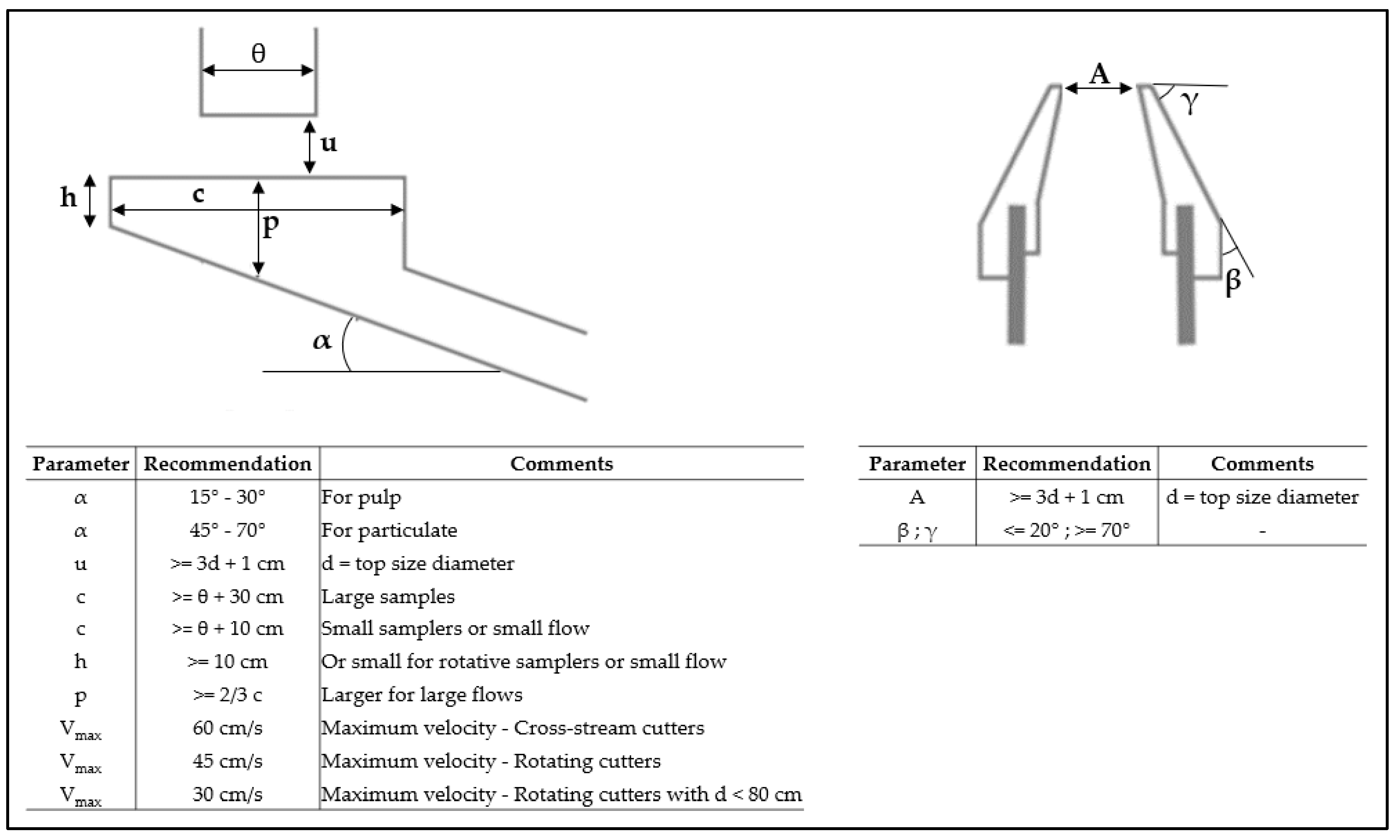
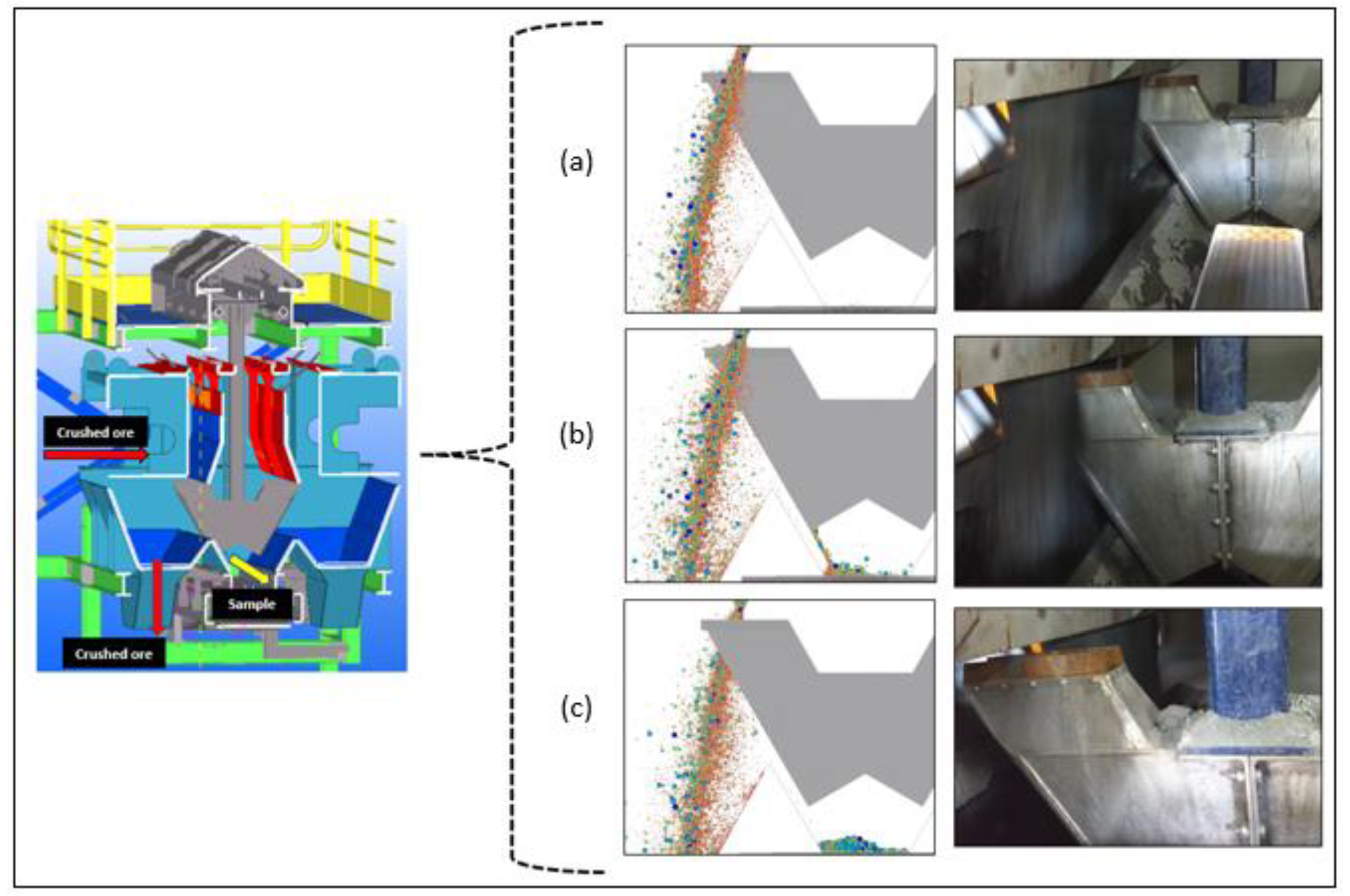
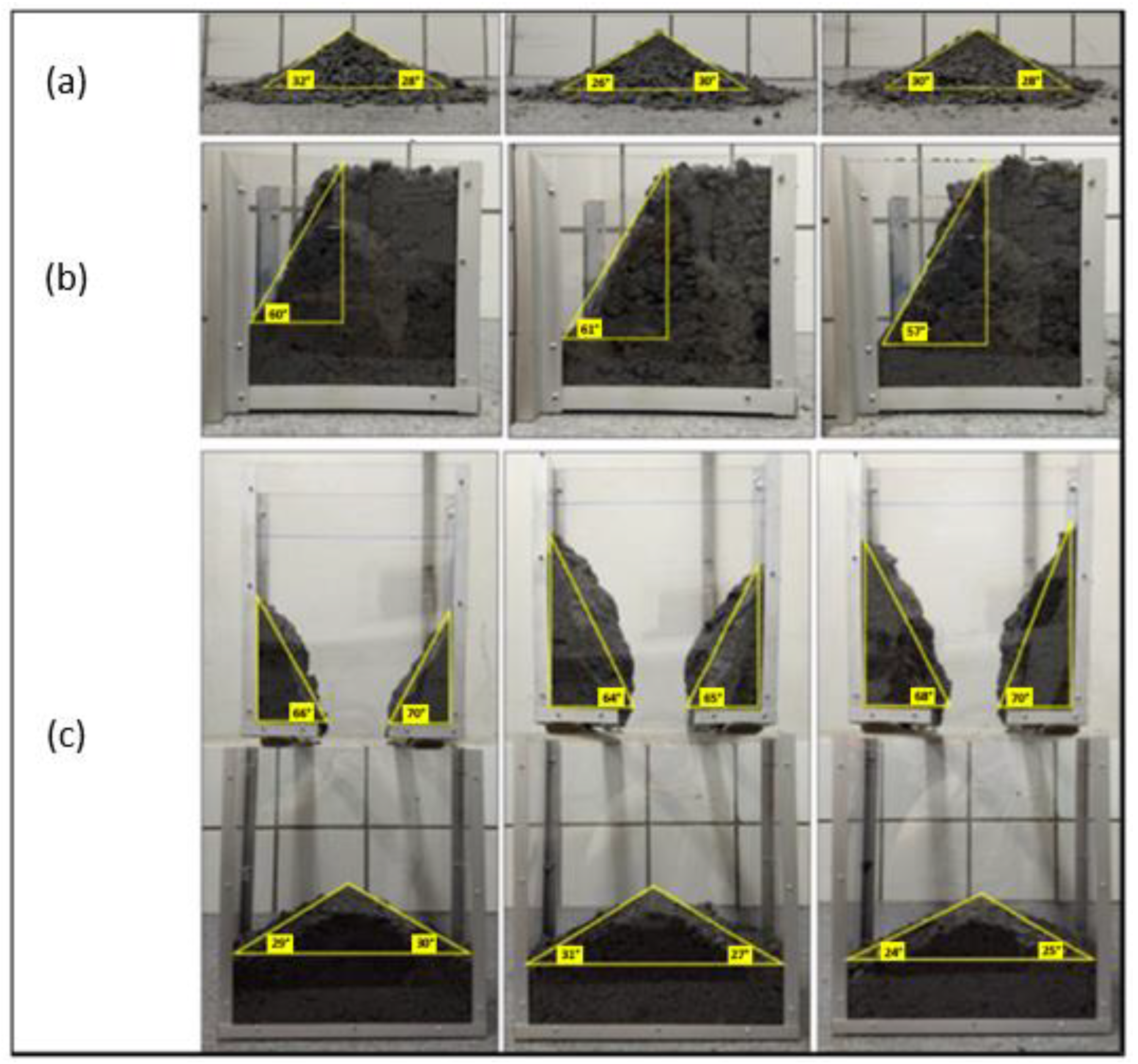
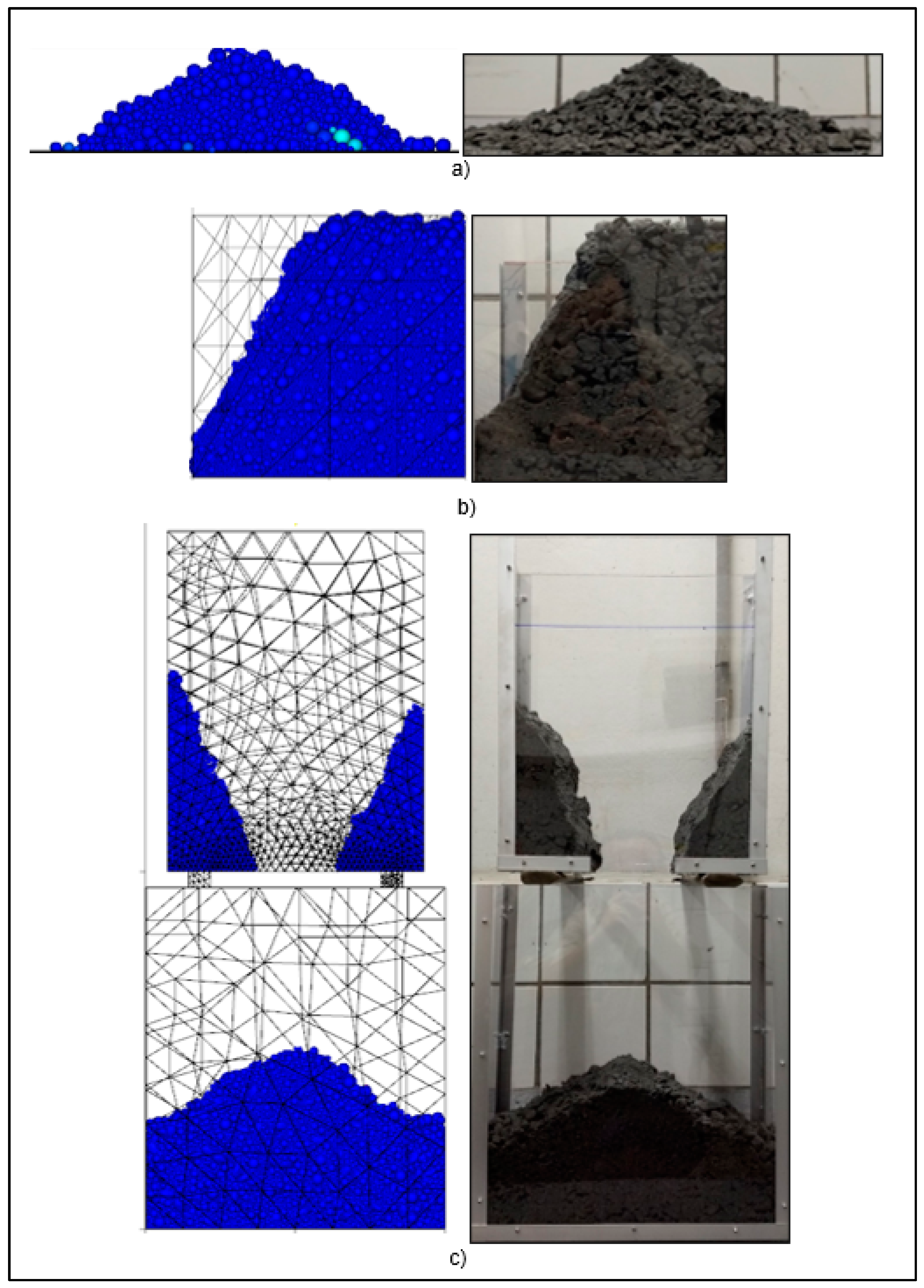



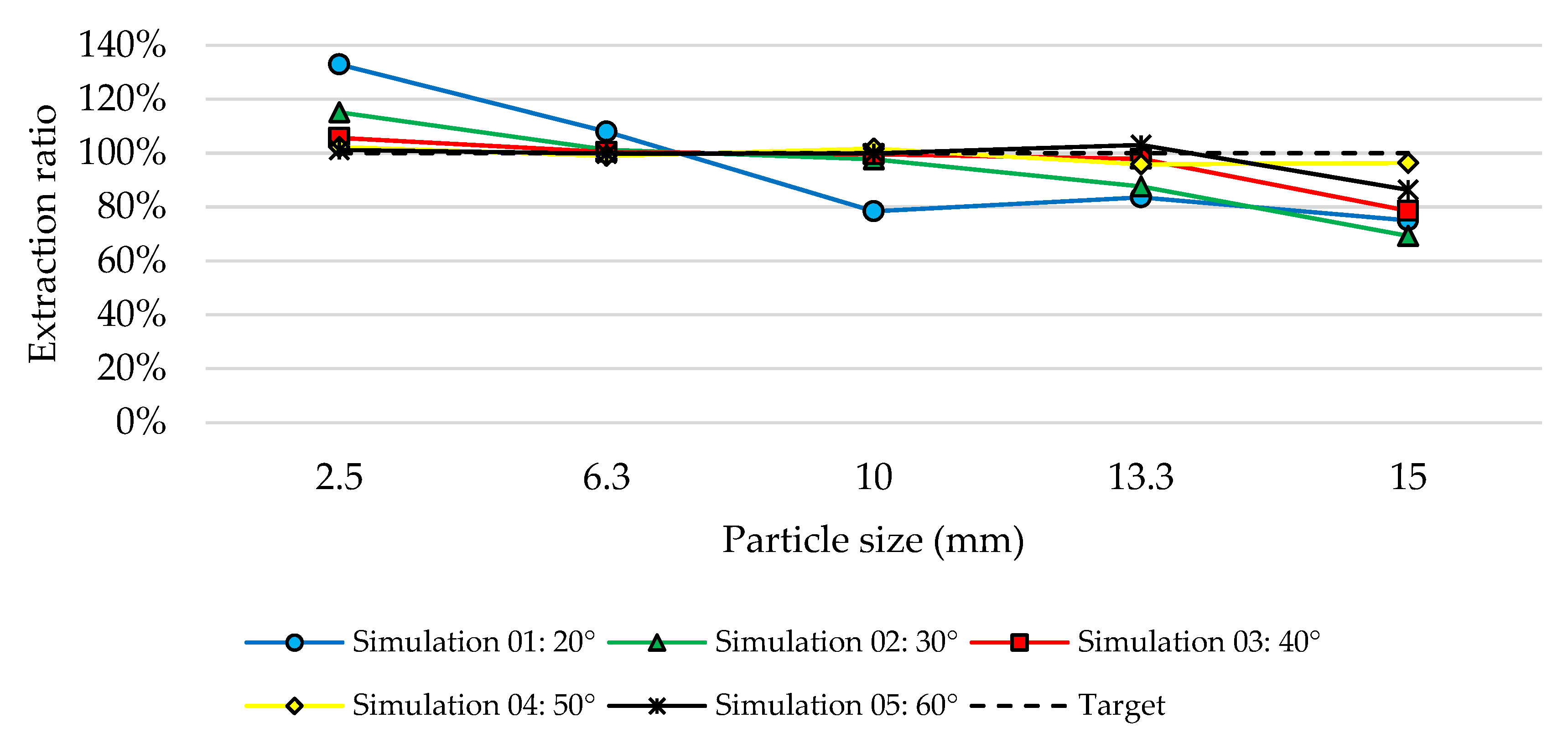
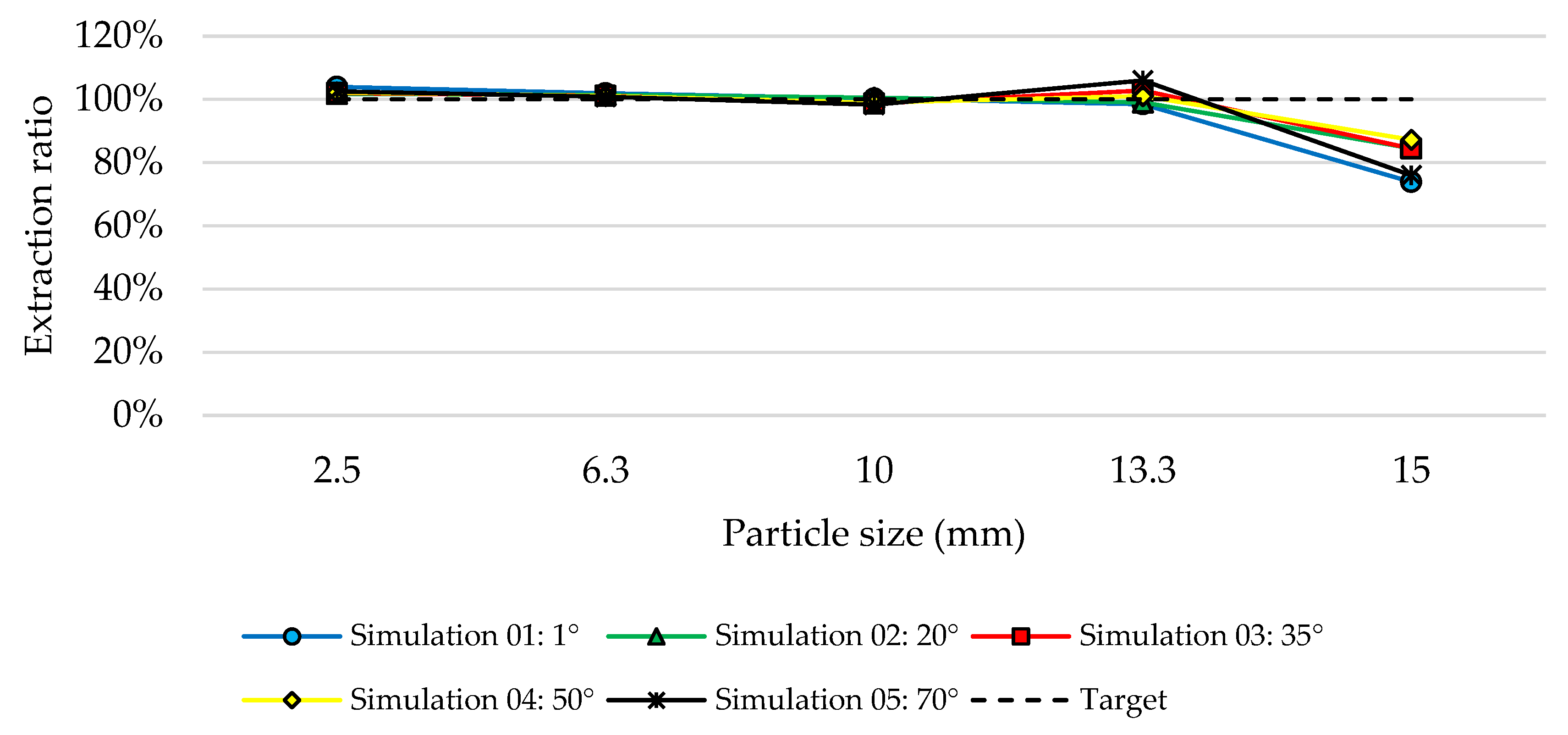
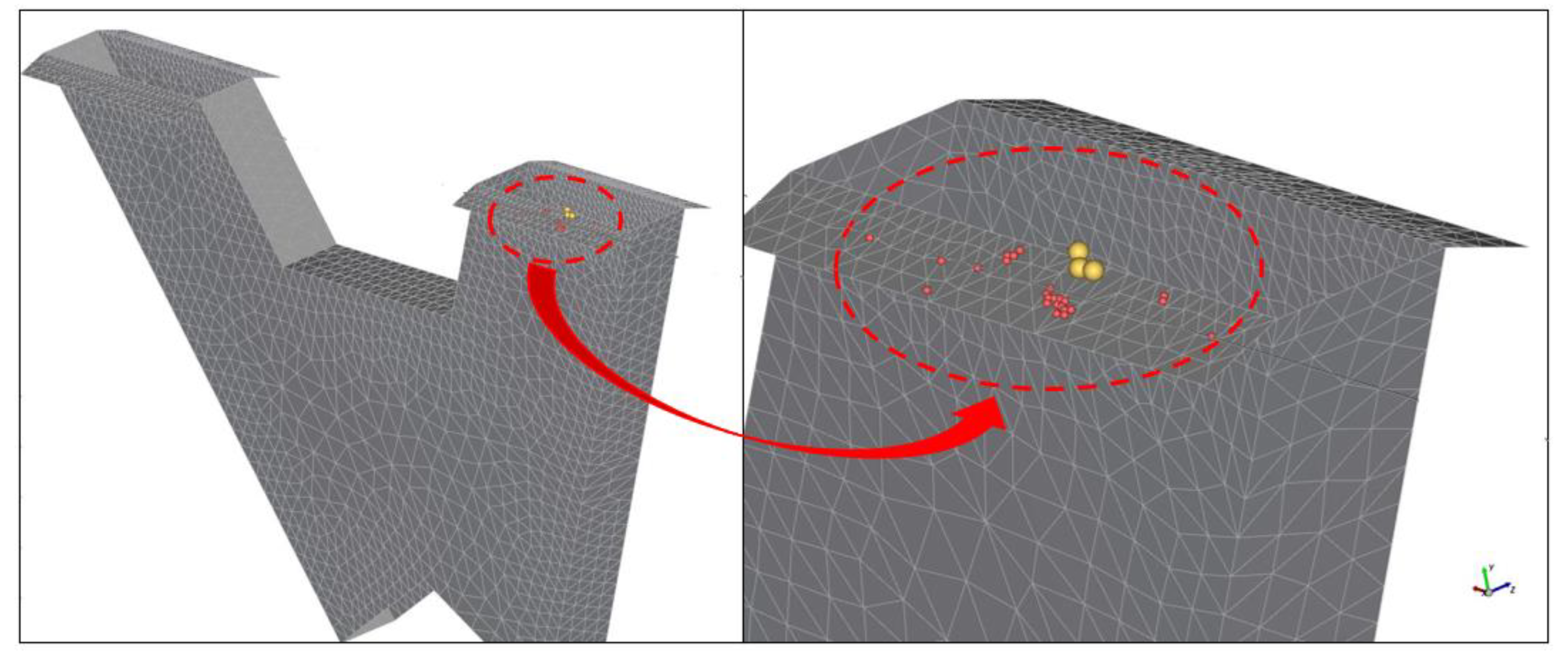
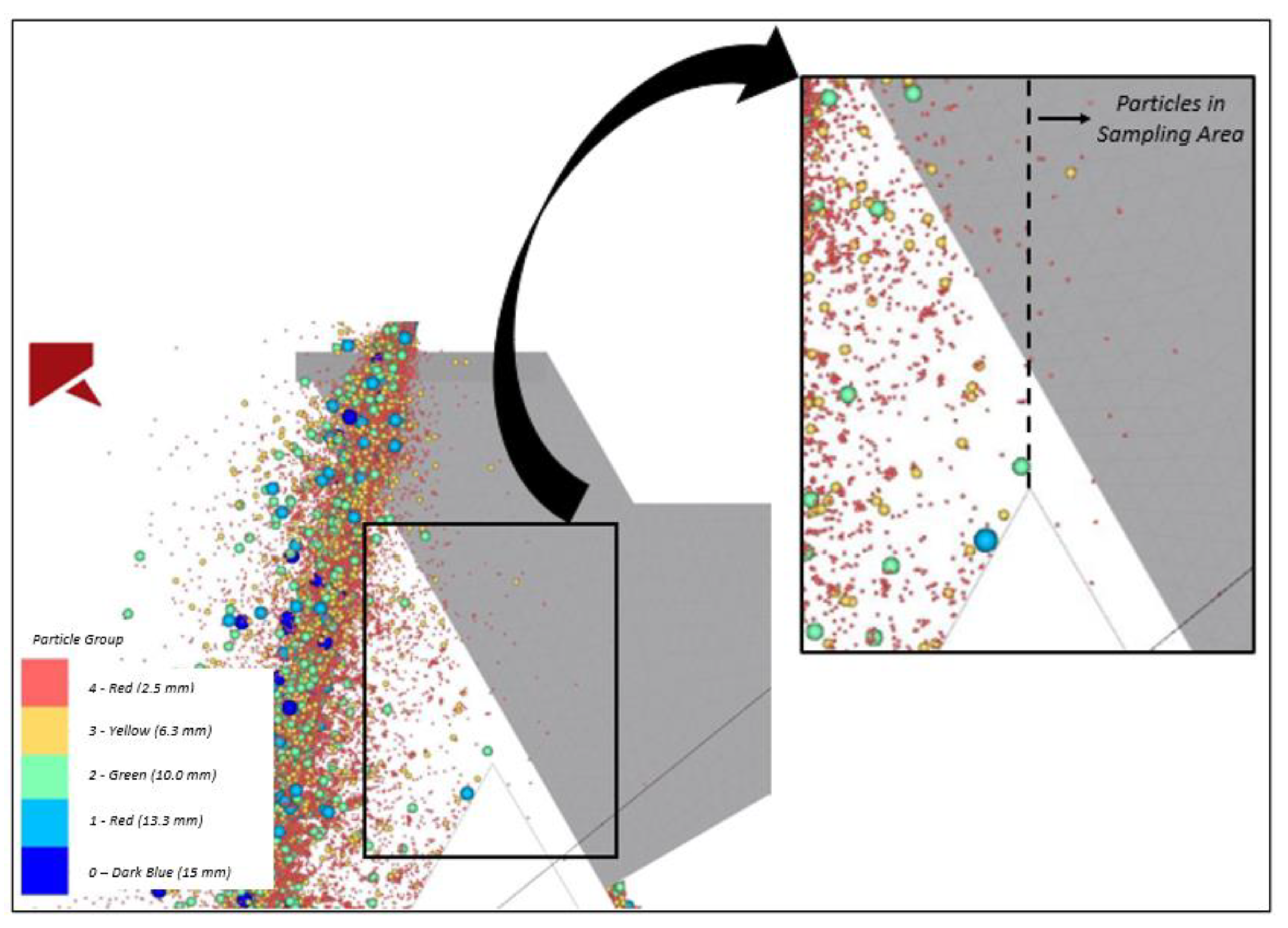
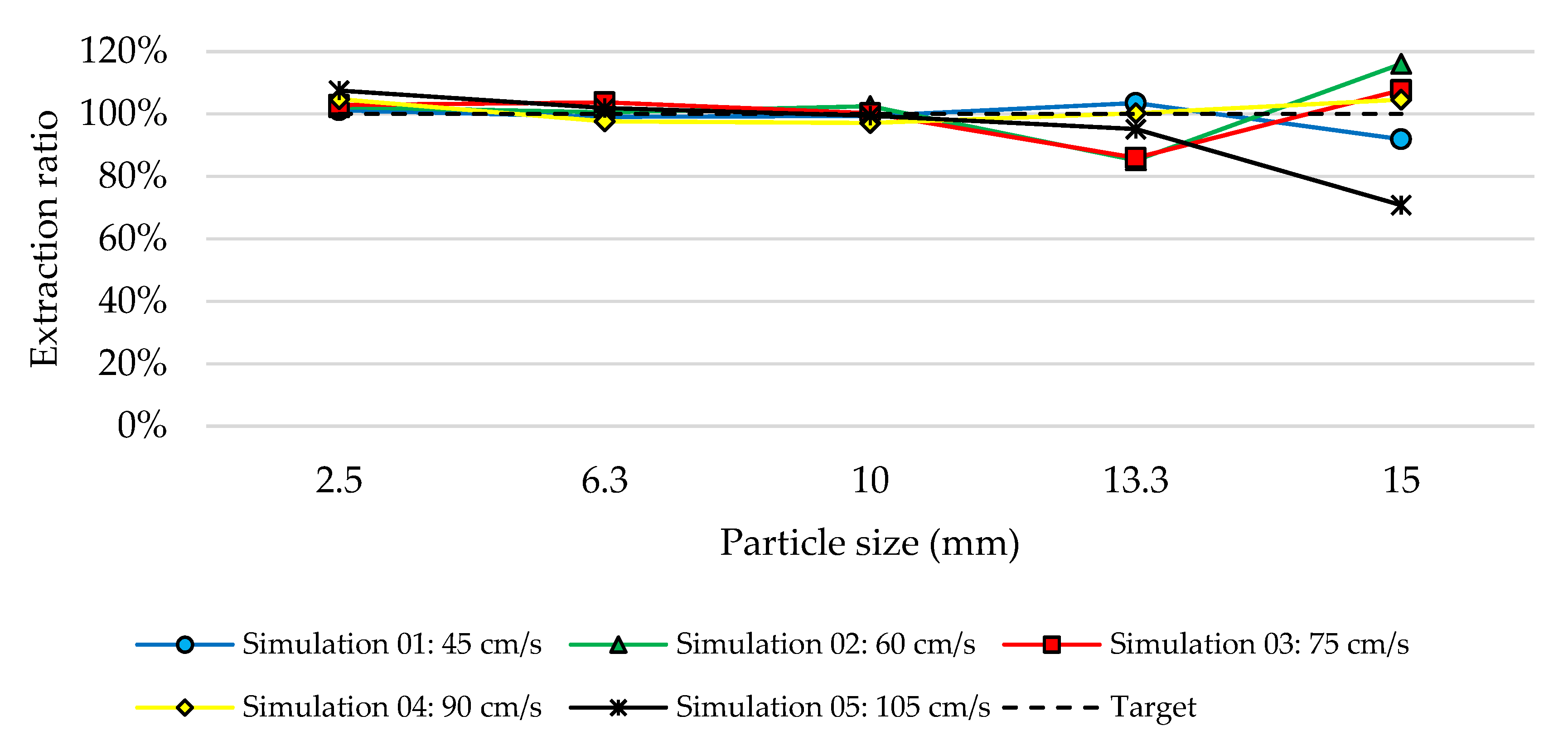
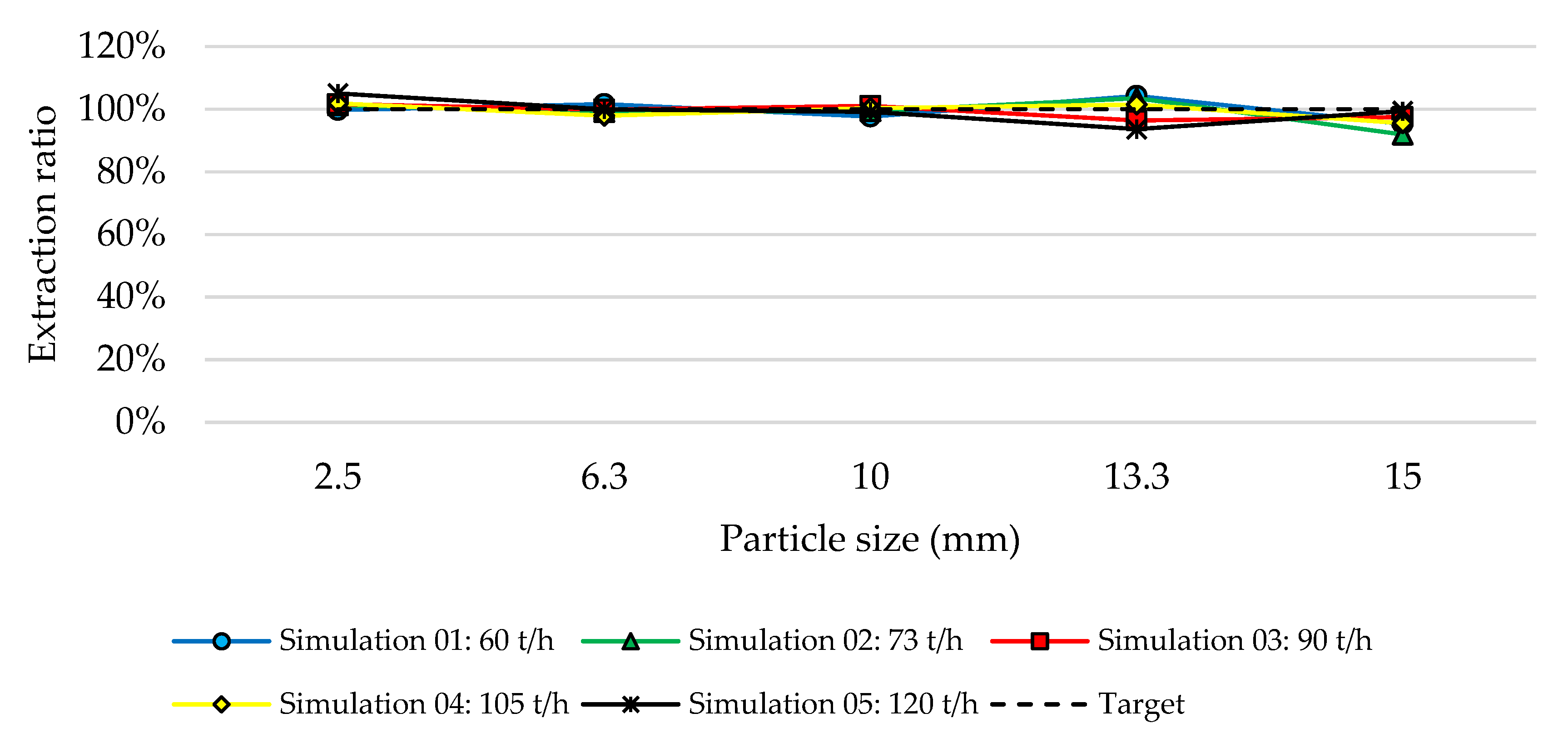
| Parameters | Level | |
|---|---|---|
| Low | High | |
| Sliding friction coefficient | 0.1 | 0.9 |
| Rolling friction coefficient | 0.1 | 0.9 |
| Attractive force | 0.5 | 1.0 |
| Levels | Cutter Aperture | Cutter Velocity | Cutter Angle | Cutter Edge Angle | Solids Feed Rate |
|---|---|---|---|---|---|
| mm | cm/s | ° | ° | t/h | |
| 1 | 15 (1D) | 45 | 20 | 1 | 60 |
| 2 | 22.5 (1.5D) | 60 | 30 | 20 | 73 |
| 3 | 30 (2D) | 75 | 40 | 35 | 90 |
| 4 | 45 (3D) | 90 | 50 | 50 | 105 |
| 5 | 60 (4D) | 105 | 60 | 70 | 120 |
| Parameters | Unit | Value | Std. |
|---|---|---|---|
| Moisture (w.b.) | % | 2.30 | 0.16 |
| Bulk density | g/cm3 | 1.70 | 0.10 |
| Particles density | g/cm3 | 2.83 | 0.01 |
| Repose angle (lifting cylinder test) | ° | 29 | 1.91 |
| Internal friction angle (shear box test) | ° | 59 | 2.08 |
| Repose angle (draw down test) | ° | 28 | 2.80 |
| Internal friction angle (draw down test) | ° | 67 | 2.56 |
| Group n° | Passing % | Size mm | Mass Distribution % | Gold Grade g/t |
|---|---|---|---|---|
| 1 | 100 | 15.0 | 5% | 1.98 |
| 2 | 95 | 13.3 | 15% | 2.23 |
| 3 | 80 | 10.0 | 30% | 2.77 |
| 4 | 50 | 6.3 | 25% | 2.47 |
| 5 | 25 | 2.5 | 25% | 3.54 |
| Response | Low Value | Target | High Value |
|---|---|---|---|
| Repose angle (lifting cylinder test) | 12° | 29° | 34° |
| Internal friction angle (shear box test) | 25° | 59° | 90° |
| Repose angle (draw down test) | 22° | 28° | 50° |
| Internal friction angle (draw down test) | 28° | 67° | 70° |
| Solution | Variables | Composed Desirability | ||
|---|---|---|---|---|
| Rolling Friction Coefficient | Sliding Friction Coefficient | Attractive Force | ||
| 1 | 0.89 | 0.61 | 0.72 | 0.79 |
| 2 | 0.69 | 0.90 | 0.58 | 0.78 |
| 3 | 0.62 | 0.90 | 0.60 | 0.76 |
| Response | Target | Solution 1 | Solution 2 | Solution 3 |
|---|---|---|---|---|
| Repose angle (lifting cylinder test) | 29 | 32 | 30 | 40 |
| Internal friction angle (shear box test) | 59 | 61 | 60 | 58 |
| Repose angle (draw down test) | 28 | Material didn’t flow | 28 | 36 |
| Internal friction angle (draw down test) | 67 | 66 | 65 |
| Parameter | Lot | Sample | ||||||||
|---|---|---|---|---|---|---|---|---|---|---|
| Size (mm) | 2.5 | 6.3 | 10.0 | 13.3 | 15.0 | 2.5 | 6.3 | 10.0 | 13.3 | 15.0 |
| Size distribution (%) | 25.0 | 25.0 | 30.0 | 15.0 | 5.0 | 25.3 | 24.8 | 29.8 | 15.5 | 4.6 |
| Grade per group (g/t) | 3.54 | 2.47 | 2.77 | 2.23 | 1.98 | 3.54 | 2.47 | 2.77 | 2.23 | 1.98 |
| Total grade (g/t) | 2.767 | 2.770 | ||||||||
Publisher’s Note: MDPI stays neutral with regard to jurisdictional claims in published maps and institutional affiliations. |
© 2021 by the authors. Licensee MDPI, Basel, Switzerland. This article is an open access article distributed under the terms and conditions of the Creative Commons Attribution (CC BY) license (https://creativecommons.org/licenses/by/4.0/).
Share and Cite
Magalhães, M.F.; Chieregati, A.C.; Ilic, D.; de Carvalho, R.M.; Lemos, M.G.; Delboni, H. Use of Discrete Element Modelling to Evaluate the Parameters of the Sampling Theory in the Feed Grade Sampler of a Sulphide Gold Plant. Minerals 2021, 11, 978. https://doi.org/10.3390/min11090978
Magalhães MF, Chieregati AC, Ilic D, de Carvalho RM, Lemos MG, Delboni H. Use of Discrete Element Modelling to Evaluate the Parameters of the Sampling Theory in the Feed Grade Sampler of a Sulphide Gold Plant. Minerals. 2021; 11(9):978. https://doi.org/10.3390/min11090978
Chicago/Turabian StyleMagalhães, Marcus Félix, Ana Carolina Chieregati, Dusan Ilic, Rodrigo Magalhães de Carvalho, Mariana Gazire Lemos, and Homero Delboni. 2021. "Use of Discrete Element Modelling to Evaluate the Parameters of the Sampling Theory in the Feed Grade Sampler of a Sulphide Gold Plant" Minerals 11, no. 9: 978. https://doi.org/10.3390/min11090978






